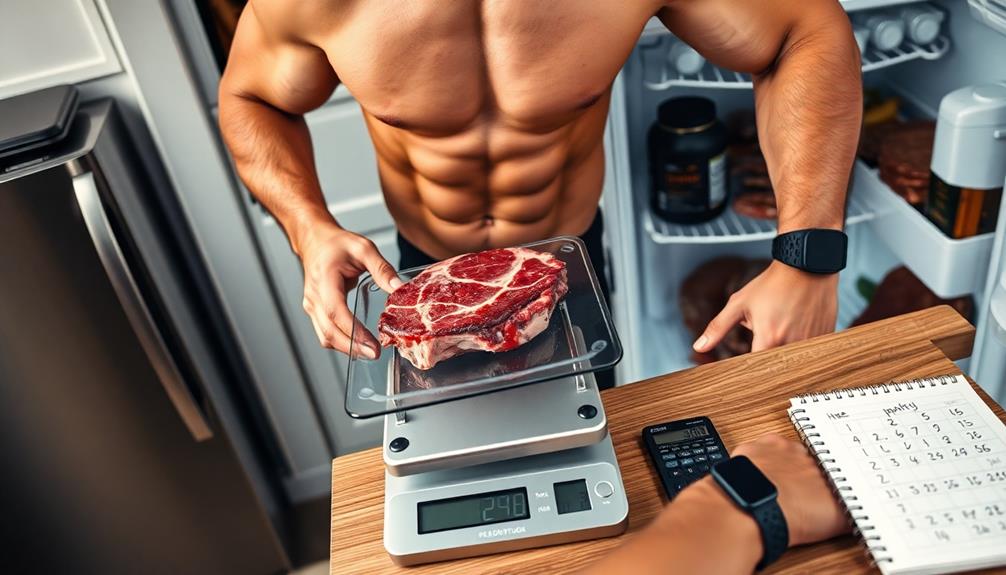To build muscle on a carnivore diet, start by calculating your protein needs based on your weight and determining your total daily energy expenditure. Optimize nutrient timing by consuming protein-rich meals before and after workouts. Design an effective workout routine focused on compound exercises and progressive overload. Address potential nutritional gaps by incorporating supplements like vitamin C, D3, and magnesium. Track your progress and adjust your approach as needed, monitoring body composition and strength gains. Remember to consume high-quality protein sources and maintain proper electrolyte balance. By following these steps, you'll be well on your way to achieving your muscle-building goals while adhering to a carnivore diet.
Core Insight
- Calculate daily protein needs by multiplying body weight in pounds by 1-1.5 for grams of protein.
- Consume meals with 20-40g protein before and after workouts to support muscle growth.
- Focus on compound exercises and progressive overload in your workout routine for strength gains.
- Address potential nutritional gaps by supplementing with vitamins C, D3, and magnesium.
- Track progress regularly and adjust protein, fat, and supplement intake as needed for optimal results.
Understanding Carnivore Diet Basics

The carnivore diet is all about eating only animal products. This means lots of meat, fish, eggs, and some dairy. No plant-based foods allowed. The idea is that these foods are packed with nutrients, easy to digest, and give you the protein and fat your body needs.
On this diet, your main foods will be beef, pork, chicken, and other meats. Fish and seafood are good too. Eggs and some dairy, like butter and hard cheeses, are also part of the plan. But you'll have to skip fruits, veggies, grains, beans, nuts, and seeds.
People who love the carnivore diet say it can help you lose weight, think more clearly, and have less inflammation in your body. But not everyone agrees. This diet is pretty controversial, and there aren't many long-term studies to prove it's safe or effective. So, it's important to do your research before diving in.
Calculating Protein and Calorie Needs

Calculating your protein and calorie needs is an important step in building muscle on the carnivore diet. To gain muscle, you need to eat enough protein and calories. Here's how to figure out your daily requirements:
- Weigh yourself in pounds
- Multiply your weight by 1-1.5 to get your daily protein intake in grams
- Find your TDEE (the calories you burn in a day)
- Add 300-500 calories to your TDEE for muscle growth
Optimizing Nutrient Timing and Frequency

Timing your meals right is key for building muscle on a carnivore diet. Plan out when you eat to boost muscle growth and recovery. Here's a simple breakdown:
Have a meal 1-2 hours before training to fuel your workout. Eat 20-30 grams of protein and 10-15 grams of fat.
After training, eat within an hour. This meal should have 30-40 grams of protein and 15-20 grams of fat to repair and grow muscle.
For lunch, aim for 30-40 grams of protein and 20-25 grams of fat. This keeps your energy up during the day.
At dinner, 2-3 hours before bed, eat 30-40 grams of protein and 20-25 grams of fat. This supports muscle recovery overnight.
Lastly, have a small meal 30 minutes before sleep with 20-30 grams protein and 10-15 grams fat. It prevents muscle loss while you sleep.
Try to eat 4 to 6 times a day, with even spacing between meals. This steady flow of nutrients helps your muscles grow and recover all day long.
Designing an Effective Workout Routine

A well-designed workout routine drives muscle growth when combined with proper nutrition timing. Focus on compound exercises that work multiple muscles at once. These exercises activate more muscle fibers and build overall strength. You can boost your results by adding muscle-building supplements, especially when used with resistance training. Choose supplements that improve strength, endurance, and recovery.
Design your workouts using these key ideas:
- Progressive overload: Slowly increase weight, reps, or sets over time
- Adequate rest: Rest each muscle group for 48-72 hours between workouts
- Variety: Change exercises regularly to avoid plateaus and stay motivated
- Proper form: Focus on correct technique instead of lifting heavy weights
Try to do 3-4 strength training workouts per week. Include exercises like squats, deadlifts, bench presses, and rows. Don't forget to schedule rest days for recovery and muscle repair. These tips will help you build muscle effectively on a carnivore diet.
Addressing Potential Nutritional Gaps

Carnivore dieters looking to build muscle should watch out for nutritional gaps. Animal foods are packed with nutrients, but you may need to fill in some holes to get the best results. Make sure you get enough vitamin C by eating organ meats like liver or taking a supplement. This helps your body make collagen and keeps your immune system strong. Vitamin D3 supplements are also important for keeping your bones and immune system healthy.
Magnesium is key for muscle function and recovery, so eat fatty fish or take a supplement. Don't forget about electrolytes like sodium and potassium. They keep you hydrated and help your muscles work properly. Just add some sea salt to your food and drink bone broth often.
Tracking Progress and Adjusting Approach

Tracking your progress is key to seeing results on a carnivore diet for muscle building. Keep an eye on your body composition, strength in the gym, and how you feel overall. Writing down what you eat can help you spot patterns between your diet and performance. Adding high-quality protein, like grass-fed whey, can boost muscle recovery and growth.
To stay on track:
- Measure your body and take photos every week
- Write down your strength gains on key exercises
- Pay attention to your energy and recovery
- Check in with your mood and mental sharpness
If you're not getting the results you want, try changing your protein, fat, and carb amounts, adjusting calories, or switching up your workouts. A nutritionist or trainer who knows the carnivore diet can help you fine-tune your plan for maximum muscle gains.
Frequently Asked Questions
Can I Consume Dairy Products on a Carnivore Diet for Muscle Building?
You can include dairy products in a carnivore diet for muscle building. They're rich in protein and calories, which can support muscle growth. However, some people avoid dairy due to lactose intolerance or personal preferences. Assess your tolerance and goals.
How Long Does It Take to See Muscle Gains on a Carnivore Diet?
You'll typically start seeing muscle gains within 4-8 weeks on a carnivore diet. However, results vary based on your genetics, workout intensity, and protein intake. Stay consistent, and you'll notice strength improvements even sooner.
Are Organ Meats Necessary for Optimal Muscle Growth on a Carnivore Diet?
While organ meats aren't strictly necessary, they're highly beneficial for muscle growth on a carnivore diet. You'll get a wider range of nutrients, including vitamins and minerals that support muscle development. Consider incorporating them for best results.
Can I Build Muscle on a Carnivore Diet Without Using Protein Supplements?
You can build muscle on a carnivore diet without protein supplements. Your body will get ample protein from meat sources. Focus on consuming enough calories and high-quality animal proteins. Consistency in your workouts is also essential for muscle growth.
How Does a Carnivore Diet Affect Testosterone Levels for Muscle Building?
A carnivore diet can potentially boost your testosterone levels, which is beneficial for muscle building. You'll likely see increased T levels due to higher fat intake and reduced inflammation. However, individual results may vary based on your specific diet and lifestyle.

